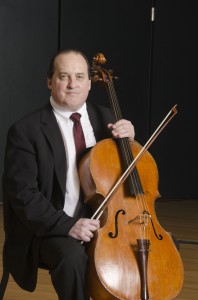A Modest British Invasion at the Timken
Cellist Ronald Thomas and four other first chair players from the Mainly Mozart Festival Orchestra offered a compact and pleasantly offbeat program in the modest-sized but tasteful Timken atrium. While there was nothing revolutionary or even mildly challenging about this program of music by Frank Bridge, Benjamin Britten and Franz Joseph Haydn, at least it was an improvement over the typical rehash of 19th-century standards that benumbs far too much of San Diego’s chamber music fare.[php snippet=1]
In his opening remarks, Thomas noted that the Bridge’s “Three Idylls for String Quartet” contained the melodic material that supplies Britten’s “Variations on a Theme by Frank Bridge” with its thematic quotation, explaining that the Mainly Mozart Orchestra would play this larger Britten work later in the festival (June 14 at the Balboa Theatre). Although little known or appreciated in North America, Bridge was Britten’s composition teacher and mentor, so it was instructive to hear the two works—Bridge’s “Three Idylls for String Quartet” and Britten’s “Phantasy Quartet for Oboe and String Trio”—back to back.
Unlike the members of the Second Viennese School and other early 20th-century European composers, these two Brits had no quarrel with tonality, although they avoided the cloying harmonic cadences of their compatriots Delius and Butterworth. The first Bridge “Idyll” begins with a plaintive, minor mode viola solo—Bridge was a violist—and luxuriates in an introspective mood that dominates the entire work. Violinists Martin Chalifour and Marie Bérard made the most of their contrasting, energetic duos, notably the tender capriccio that opens the third “Idyll.” Their elegantly matched silvery sonorities provided a welcome foil to Mark Holloway’s burnished viola timbre, and Ronald Thomas’ chocolaty cello firmly undergirded this nimble ensemble.
The angular melodic contours and dense textures of Brittens’s single movement “Phantasy Quartet for Oboe and String Trio,” Op. 2, completed and published while Britten was yet a university student, clearly reflect Bridge’s influence on his young pupil. Oboist Nathan Hughes chose a slender, incisive tone to communicate the soloist’s evanescent, mercurial quality, although he enriched his timbre in the pastoral mid-section, and his clean, agile articulation proved deeply satisfying at every turn. I believe Britten’s instrumental music is sadly undervalued, especially the later string quartets, but even this youthful work shows an inventive spirit that never stoops to facile pleasure.
To conclude the program, the four string players returned for a playful but judiciously balanced account of Haydn’s String Quartet in E-flat Major, Hob. III:38. This proved nothing less than a tour de force for Chalifour, who was given by the composer endless volleys of captivating melodies, which he dispatched with aristocractic vigor. In 1995 Chalifour became Principal Concertmaster of the Los Angeles Philharmonic, renowned for its commanding, muscular prowess, but he has nonetheless retained that luminous refinement that made him stand out as a soloist in the earliest days of Mainly Mozart. His hair is grayer now, but his playing has lost not a whit of its youthful allure.
[box] The Chamber Players series of the Mainly Mozart Festival 2014 opened with this concert at the Timken Museum of Art in Balboa Park on Thursday, June 5, at 7:30 p.m. The remaining concerts in this series will be given in the same venue on June 12 and June 19 at 7:30 p.m.
An additional concert at the Ruby G. Schulman Auditorium in Carlsbad will be presented on June 15 at 2:00 p.m.
www.mainlymozart.org[/box]

Ken Herman, a classically trained pianist and organist, has covered music for the San Diego Union, the Los Angeles Times’ San Diego Edition, and for sandiego.com. He has won numerous awards, including first place for Live Performance and Opera Reviews in the 2017, the 2018, and the 2019 Excellence in Journalism Awards competition held by the San Diego Press Club. A Chicago native, he came to San Diego to pursue a graduate degree and stayed.Read more…

